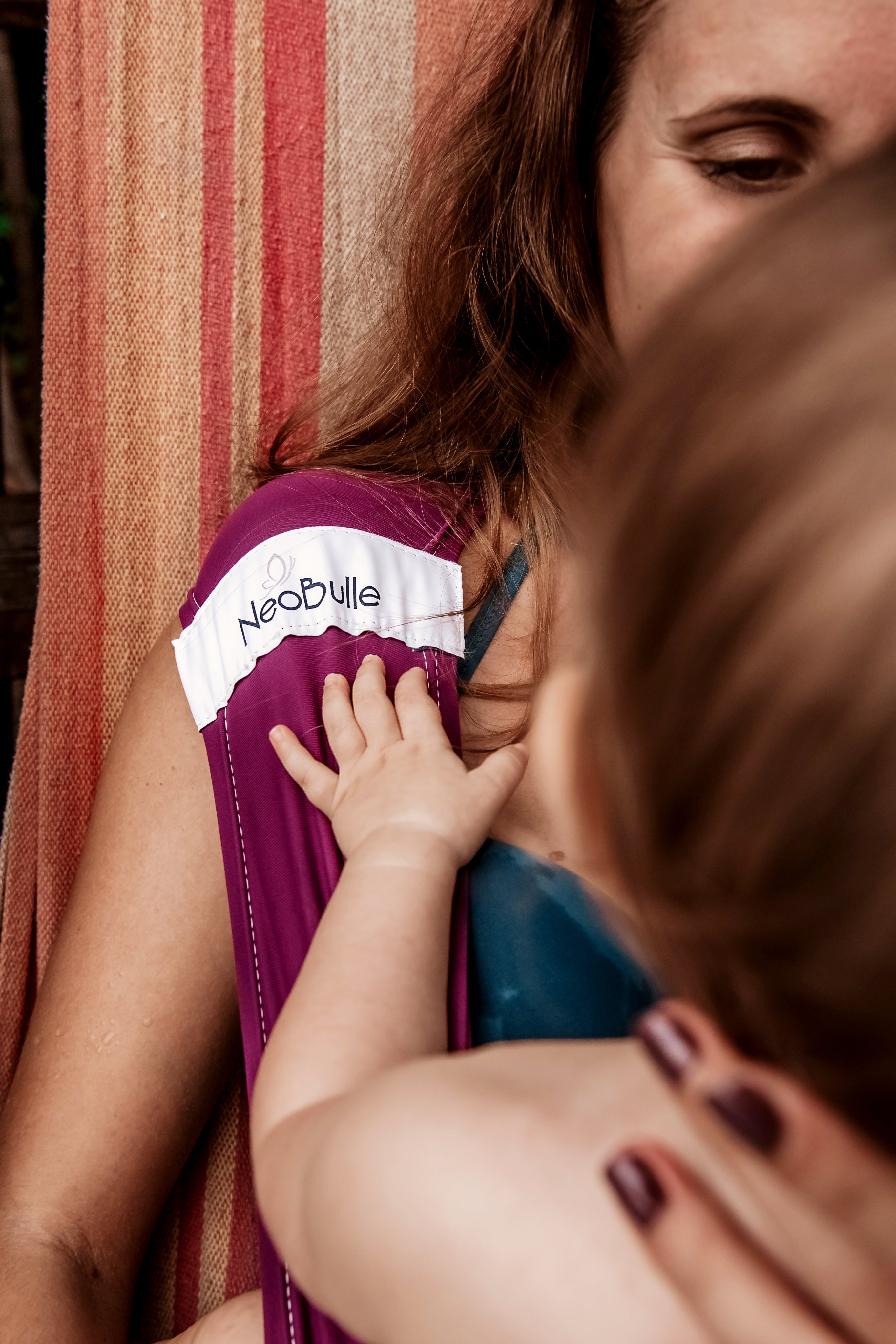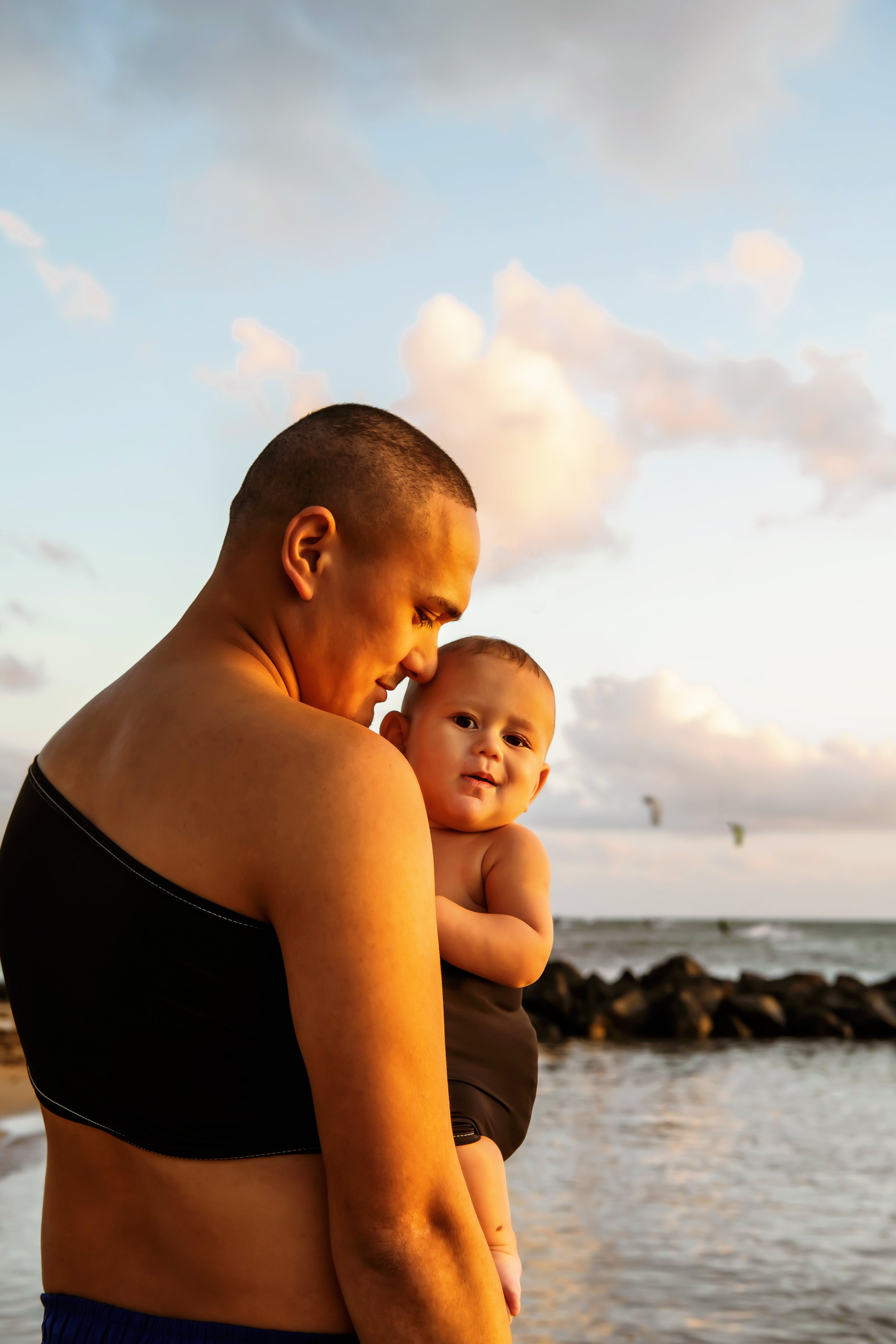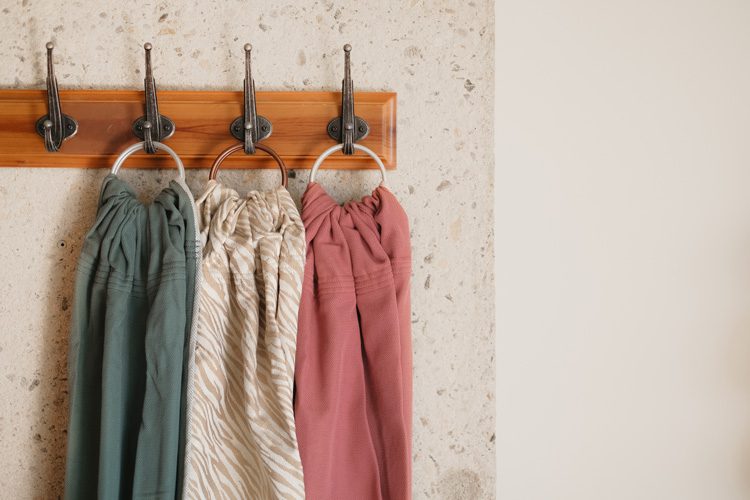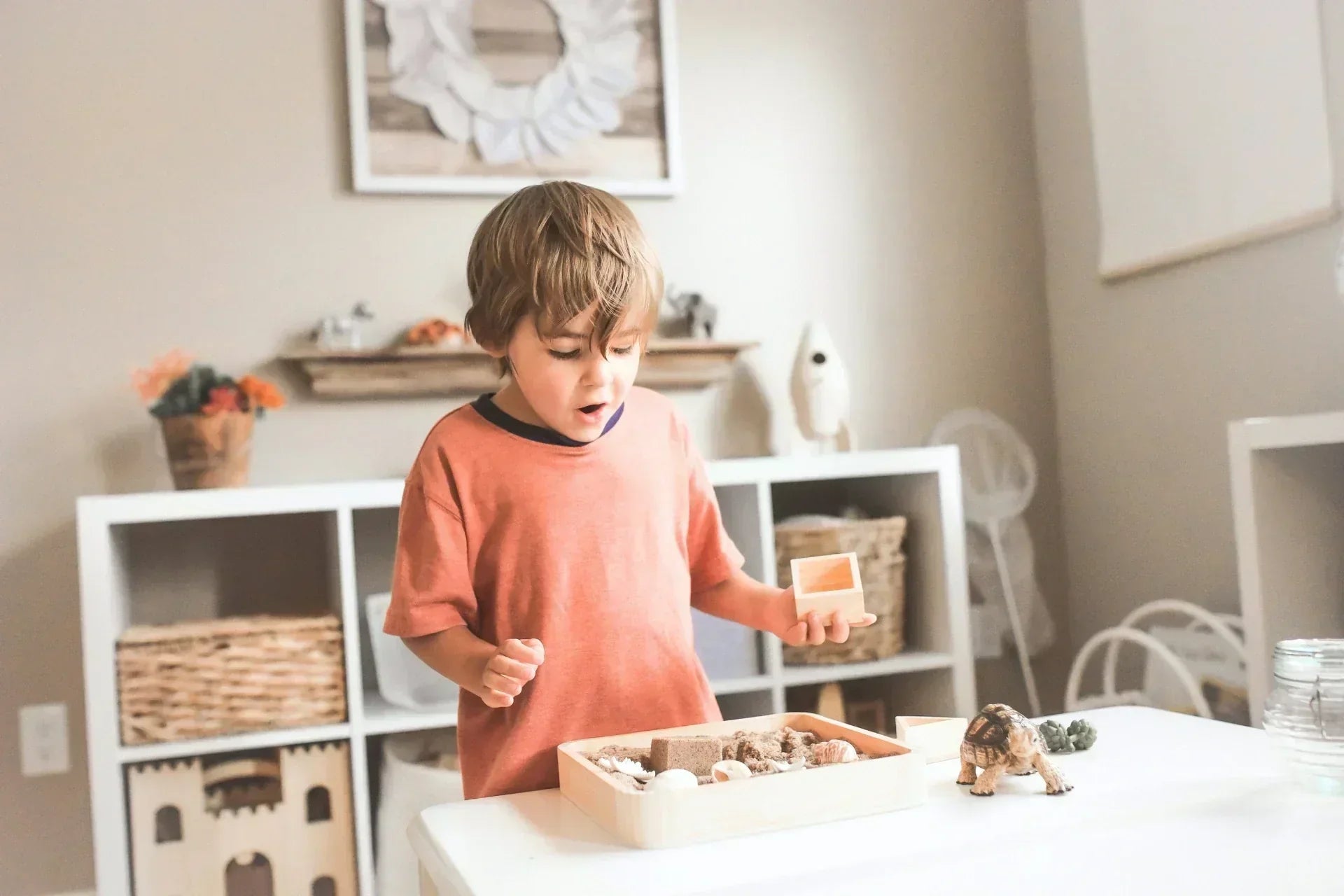- In a more supportive and breathable fabric?
- In a more enveloping knit but less durable?
- Preferably basic, easy-to-care-for cotton or a firmer linen?
- Or maybe a bit of viscose to smooth everything out and add a little breeze of freshness?
Here you are lost in the jungle of babywearing and the many choices available to you.
Need help understanding better? We offer a small article to review the commonly used materials in baby carrier manufacturing and their impact on use.
1 – Fabric or knit?
The very first notion to know, the most important, is the distinction between fabrics and knits. Did you think that all wraps were just large pieces of fabric, almost identical?
Actually, there are three models divided into two main categories: woven and knitted, with or without elastane! Knowing which category your item belongs to significantly impacts how you will use it!
Knit is made from a single yarn, usually cotton, knitted. Of course, not with grandma’s needles: an industrial knitting machine is used. This results in a fabric that is more or less stretchable: take your T-shirt, for example, it’s a knit.
Knits entirely made of cotton have a stretch without memory: when you stretch the fabric, it remains deformed afterward. In babywearing, this fabric is pleasant for carrying a newborn but often very little durable: as the baby grows and gains weight, the knit stretches and the child is poorly supported inside, making installation uncomfortable. The thinner the knit, the less supportive it is, if your wrap is so thin that it’s transparent, it’s rather a bad sign for its durability.
If the composition label is inaccessible, you can recognize these materials by their behavior: stiff when stretched lengthwise, rather soft and slightly deformed widthwise.

Note that the instructions for wraps sold with these wraps often do not match their actual use and suggest impractical knots (notably the "basic knot" style, which is performed entirely before placing the child, but can only be offered with knits containing elastane in combination with cotton).
Knits containing a bit of elastane or spandex in addition to cotton (around 5% generally) benefit from a shape memory that allows the fabric to return to its original shape after stretching. These are much more dynamic knits and are therefore more supportive.
that their counterparts without elastic. If we want to play on semantics, we can talk about elastic stretchy wrap in addition to extensible.The obtained answer allows the wrap to be used for several months, the actual durability then depends on its width and density, on average we are between 4-6 months and 12-18 months.

Knitted wraps all require 2 to 3 layers of support materials on the baby's back to be safe: simple layer knots like a kangaroo or a crossed-wrapped swaddle with non-deployed panels are not suitable. In most cases, their use for back-carrying is also discouraged.
The fabrics are made on a loom, with several warp and weft threads. The weaving used in carrying is what is called twill-weave. We spare you the technical details; basically, when you take a piece of cloth (e.g., a dish towel), it is very stiff when pulled along its length and width, but very stretchable diagonally with a tendency to deform (see the linen pants that seem to grow 4 sizes after 10 minutes of walking? This is due to the deformation of the fabric!). We do not use fabric for making wraps because the rigidity along the lengths tends to cut into the edges and the deformation diagonally is not optimal for providing good support to the baby. It would be safer but less comfortable.
The broken twill is less 'dry' in length and width, and elastic diagonally (see for knits if you followed closely: stretchable but with a shape memory that offers more resistance). For example, jeans are made with twill weaving (not broken, but it’s similar!)
Woven wraps are very durable, they can withstand traction forces of over 700kg without flinching (Note: if your baby reaches this weight: consult!). A single layer is enough to provide good support for your little one, which especially allows for kangaroo knots.



2 – So, what is better?
Is everyone still with me? Let’s continue!
The choice between knit or fabric is mainly subjective: carrying is primarily a matter of sensations!
Knits provide sensations extremely enveloping, especially those with elastane that give a true second skin effect. You become one with your baby! They are less durable than fabrics but are also less expensive: this can allow at a lower cost to first see if you enjoy carrying before investing in another system that will go further. It is not uncommon to start the first weeks with a sling, then switch to a mei-tai or preformed carrier when the baby grows and/or when you want to carry him on your back with less technical setups.
On the other hand, contrary to popular ideas, they are often more technical to handle: when you pull on the material, it deforms before tightening, and it only tightens if you pull in the right direction! The lack of feedback can sometimes challenge a beginner who will have difficulty assessing if their adjustments are correct.
Another negative point to consider: they are warm scarves! 3 layers of fabric + the synthetic elastane: beyond 20-25°C, this can become quite uncomfortable!
Finally, elastane is a material that has a limited lifespan. Even (and especially) useless in a closet, the sling wears out: do you see the old pair of socks forgotten in a drawer? the elastic that makes CRRRRCCCRCRRRR and breaks when you pull on it? Same thing. At least the sling does not tear and remains safe, but it becomes stiff and much less comfortable. So avoid it occasionally.
Fabrics are, on the other hand, very durable and can be used to carry multiple children (or even their own children later on!). The weaving is generally more breathable than knitting, which needs to be very dense to be supportive, and since it is only used in one layer, it is perfectly usable even in the summer (see the article on summer carrying).
Woven scarves suffer from a poor reputation of being difficult to handle and a bit stiff: as you will understand, this is not the case! They offer a very pedagogical feedback that allows you to feel the adjustments well, and the signs of good quality are soft and flexible from the first uses.
3 – What about the material?
Beyond the notions of yarn work, the composition of the yarn also matters: cotton, linen, hemp, wool, silk, bamboo viscose… You will not get the same result depending on the chosen material!
Classically, cotton remains the most used fiber: versatile, soft, lightweight, and easy to wash, it has the ideal characteristics!
Linen and hemp are regularly mentioned for summer: if they are indeed cooler, their fibers are also more rigid. This makes the sling a bit stiffer and less easy to adjust. With some exceptions, baby carriers containing linen or hemp are generally intended for heavier toddlers and who stand well enough for their musculature to compensate for less precise adjustments, they are more supportive That is to say, with a thickness equal to cotton, you will feel less the weight of your child with.
Silk and wool are materials that are thermoregulators: they keep you warm in winter but stay cool in summer. They are often slightly more elastic than cotton and very pleasant if you can tolerate the somewhat "prickly" side of wool (even if high-quality wools are very soft and have nothing to do with the sweaters and balaclavas that traumatized us as children!). The main downside remains their more delicate maintenance, to be avoided with a baby who regurgitates a lot!
Viscose are synthetic materials but generally cool and very fluid. They give scarves great flexibility and are highly appreciated in combination with cotton for carrying very young children and for summer.
4 – Where are the Neobulle ranges located?
My sling, My cocoon and My neo are carrying systems made of knitted: they are therefore stretchable and enveloping, designed for carrying in the first year of the baby.My sling is sewn in 100% cotton knit but features a high density that despite being used in a single layer provides quite surprising support!
My cocoon is made of a blend of bamboo viscose and elastane, making it a stretchy scarf. Bamboo largely reduces overheating associated with the three layers it requires, making it ideal for front carrying only.
The vast majority of other ranges are made of cotton either woven with a broken serge weave or jacquard weave: jacquard is a much more complex technique that creates a pattern and is therefore more aesthetic. The resulting fabric is also more flexible, softer, and more pleasant to handle and adjust.
Finally, the slings and classic range scarves feature a combination of cotton and seaweed viscose, which gives them a great feeling of freshness and more fluidity.
All that's left is to choose the colors, and this time: we can't help you anymore!!!!










